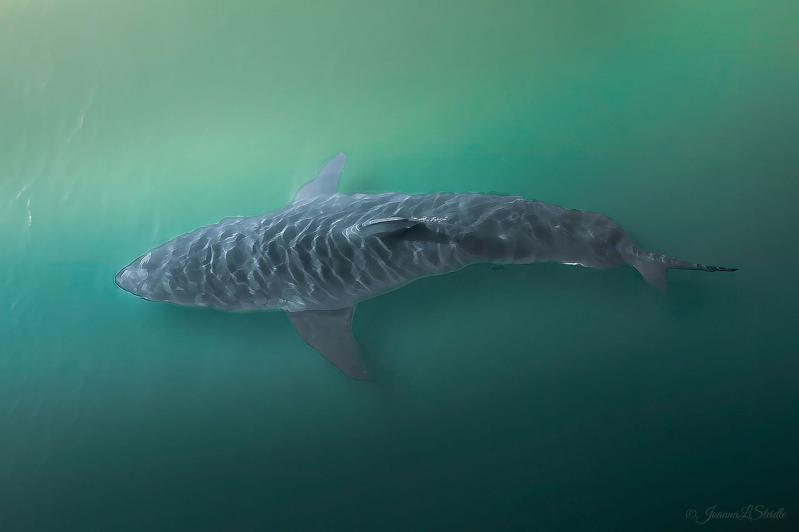A certain New York City tabloid did its best to sensationalize drone footage captured this month depicting a great white shark a few hundred feet off the Montauk shoreline, but the sighting is neither surprising nor cause for concern, a local expert insisted.
The artist and drone pilot Joanna Steidle of Hamptons Drone Art posted the 56-second video of the apex predator on the social media platform X on May 12. It was taken that morning, she wrote, near Shadmoor State Park, a little west of Ditch Plain Beach, a popular surfing and swimming site. At 8:30 a.m., she wrote, “I spotted my first Great White Shark of the season! Just a few hundred feet from the coast of Montauk. Great whites are known to feed and breed off the coast of New York, and this should not alarm anyone.” The shark was swimming slowly, at about 3.5 miles per hour, she wrote.
Of the four or five white sharks she had previously seen, none had appeared before late June, she told The Star this week. This one was also closer to shore than any of the others, she said. Her survey of experts returned an estimate of an 11 to 13-foot-long female that is around 20 years old and possibly pregnant.
The video closely coincides with the 50th anniversary of the movie “Jaws,” which did much to frighten the public about swimming in the ocean upon its release in June 1975. The movie, which was directed by Steven Spielberg, who owns a house in East Hampton Village, and starred the late Roy Scheider, who lived on the South Fork, also spurred an interest in sportfishing for sharks. Quint, the charter boat captain hired to kill the shark that is terrorizing the fictitious town of Amity in “Jaws,” was said to be based on the late Frank Mundus, a Montauk fisherman.
But Frank Quevedo, executive director of the South Fork Natural History Museum in Bridgehampton, said that the drone footage captured nothing out of the ordinary. Rather, he said, it depicts an encouraging sign of a healthy ecosystem. “This is normal behavior for these animals, this time of year,” he said on Monday. “The only difference is somebody spotted it with a drone, unlike in other years when it was probably moving through” unnoticed. “May is the month when they start moving through, feeding on Atlantic menhaden, just like the osprey and others utilize the food source.”
The museum operates the Shark Research and Education Program, which aims to enhance stewardship of Long Island’s shark population and educate the public about their ecological importance. “These sharks have been here for millions of years,” Mr. Quevedo said. “The South Shore of Long Island is one of the only few confirmed white shark nurseries in the world — we’re very lucky to have this right in our backyard. To have this apex predator using the marine environment, it’s such a treat to know there is some balance in the ecosystem right along our beaches.”
He pointed to the 2019 New York State legislation that prohibited the use of purse seines to harvest menhaden, a crucial food source for many marine species that is also known as bunker, in state waters. Since the ban, “we’re seeing sharks returning, which means everything else that relies on it moves back,” including striped bass, other sharks, and marine mammals including whales and dolphins.
White sharks are a temperate species, Mr. Quevedo said. “They leave in the fall and early winter and head south to follow prey. This time of year, they start moving back northeast off our shores on Long Island. This is nothing abnormal.” Use of drones, he said, “allows the scientific community to better understand migration and swimming behaviors,” calling them “an added tool we can use.”
The drone footage “spurs awareness,” he said, “and it’s definitely a great tool to better understand our marine life here on Long Island.” But while “there are going to be human and predator interactions that take place, they’re not going to attack us,” he said. “It’s just an interaction — an unfortunate one, but it’s not an attack. It’s an interaction.”
For those interested in learning more about tracking sharks in New York waters, SoFo will host Tobey Curtis, the lead biologist with its sharks program and a NOAA Fisheries management specialist, talking about just that on Saturday at 4 p.m. He’ll discuss how radio tracking has helped scientists better understand shark movements. The program is free; registration is through the calendar page at sofo.org.

